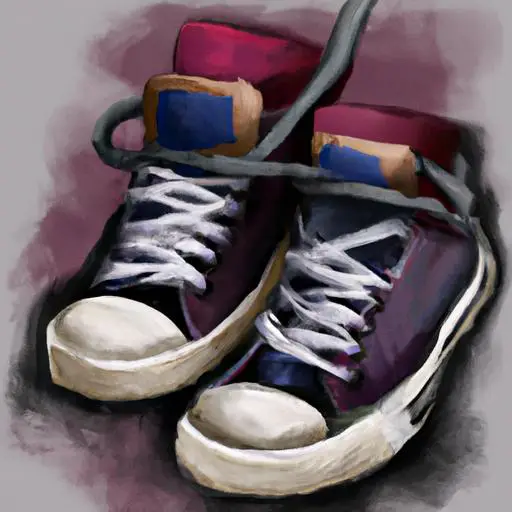Tennis shoes are an integral part of any tennis player’s wardrobenot only providing comfort and support on the court, but also helping to ensure that athletes can reach their full potential.
But what exactly makes up these shoes? What materials are used to make them so durable and comfortable? In this article, we’ll explore the materials that go into making great tennis shoes.
From rubber to foam, leather to mesh, and even synthetic fabrics, we’ll examine the components that make up the perfect tennis shoe.
We’ll also look at the differences in materials used in tennis shoes for men and women.
So let’s get started on our journey to discover the secrets of what makes a great tennis shoe!
Table of Contents
Short Answer
Tennis shoes are typically made out of a combination of materials, including leather, synthetic fabrics, rubber, and foam.
The soles of tennis shoes are usually made from rubber which provides durability, traction, and cushioning.
The upper parts of the shoes are typically made of breathable materials such as leather and synthetic fabrics to help keep the foot cool and comfortable.
Foam is often used around the heel and tongue areas of the shoe to provide additional padding and shock absorption.
What is a Tennis Shoe?
A tennis shoe is an essential piece of footwear for any tennis player, providing the necessary support, cushioning, and protection needed to take on the court.
It is designed to have a grip that is both firm and flexible, allowing for maximum performance and comfort during play.
Additionally, they are designed to be lightweight and breathable to ensure optimal comfort during long matches.
Tennis shoes are typically made of a combination of materials, including rubber, foam, leather, synthetic fabrics, and mesh fabric.
The rubber sole provides the necessary traction on the court, while the foam provides cushioning and support.
The upper part of the shoe is often made from a combination of leather and mesh fabric to provide breathability and durability.
Additionally, some tennis shoes feature synthetic fabrics that are designed to be lightweight and provide comfort.
The inner lining of a tennis shoe is often made from a breathable, moisture-wicking material to keep the feet dry and comfortable.
This inner lining helps to reduce the risk of blisters and skin irritation, as well as providing additional cushioning and support.
Furthermore, many tennis shoes also feature an extra layer of cushioning along the heel for additional comfort and shock absorption.
The soles of a tennis shoe are designed to provide the necessary grip on the court.
Tennis shoes usually feature a herringbone pattern, which helps to provide maximum traction and grip while playing.
Additionally, many tennis shoes feature a layer of cushioning along the sole to provide extra comfort and shock absorption.
Finally, many tennis shoes also feature an outer layer of synthetic material to provide additional durability and protection.
This outer layer helps to protect the shoe from damage, while also preventing dirt and debris from entering the shoe.
Rubber

When it comes to tennis shoes, rubber plays a crucial role in their construction.
Most tennis shoes feature a rubber outsole, which is designed to provide traction on the court and protect the feet from wear and tear.
The rubber outsole is often made from a combination of materials such as rubber, synthetic rubber, and natural rubber.
The rubber outsole provides the necessary cushioning and grip to help the player move around on the court without slipping.
Additionally, some rubber outsoles are designed with a tread pattern, which helps to increase the grip and provide better traction on the court.
In addition to the outsole, some tennis shoes also feature a rubber midsole.
The midsole is designed to provide cushioning and support for the foot, and it is usually made with a combination of materials such as foam, rubber, and air.
The midsole helps to absorb the impact from running and jumping, which can help to prevent injuries.
The rubber midsole also helps to provide stability and support.
Finally, some tennis shoes also feature a rubber toe guard.
This is a thin piece of rubber that is placed over the toes to protect them from abrasion and wear.
The rubber toe guard helps to provide extra protection and cushioning for the foot, especially when the player is making quick turns on the court.
Foam
When it comes to tennis, having the right shoe is essential.
Not only does it provide you with the necessary traction and grip on the court, it also offers cushioning and support.
One of the key elements in a tennis shoe is foam, which is usually found in the midsole and the heel of the shoe.
The foam acts as a shock absorber and helps to cushion the foot against the rough surfaces of a tennis court.
It also helps to provide stability and support, allowing you to move around the court more easily.
Foam is usually made from a combination of materials such as ethylene-vinyl acetate (EVA) and polyurethane (PU).
EVA foam is lightweight and provides good cushioning, while PU foam is more durable and provides greater support.
Depending on the type of shoe and the intended use, different types of foam can be used to provide the best combination of cushioning, support and durability.
Another type of foam that is commonly used in tennis shoes is air foam, which provides extra cushioning and is lighter than traditional foam.
When it comes to selecting the right foam for your tennis shoes, it is important to consider the individual needs and preferences of each player.
Different types of foam will offer different levels of cushioning, support and durability, so it is important to choose the foam that best suits your playing style and the surfaces you are likely to be playing on.
Leather and Mesh

When it comes to tennis shoes, leather and mesh fabric are two of the most common materials used in their construction.
Leather is often used in the upper part of the shoe, as it provides durability and breathability.
The leather also helps to keep the shoe form-fitting and comfortable on the foot.
Mesh fabric is also used in the upper part of the shoe, as it helps to provide ventilation and breathability.
The mesh fabric is usually lightweight, which helps to reduce the overall weight of the shoe and makes it more comfortable to wear.
Additionally, mesh fabric helps to keep the foot cool and comfortable, even during intense matches.
The combination of leather and mesh fabric helps to create a strong and flexible shoe that provides support and comfort while also allowing the foot to breathe.
Synthetic Fabrics
When it comes to the materials used in making tennis shoes, one of the most popular is synthetic fabrics.
Synthetic fabrics are typically lightweight and designed for maximum comfort and breathability.
These fabrics are made from synthetic materials, such as polyester or nylon, and are often used in combination with other materials to create a shoe that has the desired look and feel.
Synthetic fabrics offer a wide range of benefits, including being very durable and resistant to wear and tear, as well as being very light in weight.
Additionally, synthetic fabrics are often treated with water-resistant and/or anti-microbial treatments to help keep your feet dry and comfortable during intense matches.
Synthetic fabrics also provide great support and flexibility to the wearer, allowing them to move freely on the court.
Technology and Materials Used in Tennis Shoes

Tennis shoes are designed to provide the best performance and comfort on the court, and they need to be made from the right materials to ensure they meet those requirements.
Tennis shoes are typically made from a combination of materials, including rubber, foam, leather, synthetic fabrics, and mesh fabric.
Each of these materials serve an important purpose in creating a comfortable and effective shoe.
The rubber sole of the shoe provides the necessary traction on the court.
It is designed to grip the ground, allowing for better control and agility during movement.
Foam provides cushioning and support, reducing the impact of hard landings and providing a comfortable fit.
The upper part of the shoe is usually made from a combination of leather and mesh fabric.
The leather provides durability and protection, while the mesh fabric allows for breathability and ventilation.
Additionally, some tennis shoes feature synthetic fabrics that are designed to be lightweight and provide comfort.
These fabrics are often lightweight, stretchy, and moisture-wicking, making them ideal for a sport that involves a lot of movement and sweat.
The materials used in tennis shoes are carefully selected to ensure they provide the comfort, support, and traction needed to perform at a high level.
With the right combination of materials, a tennis shoe can provide the perfect combination of protection and performance.
Differences Between Mens and Womens Tennis Shoes
When it comes to tennis shoes, men and women have different needs.
Men typically prefer more cushioning and support, while women often prioritize lightweight construction and breathability.
To achieve this, manufacturers use different materials and design elements when constructing mens and womens shoes.
Mens shoes typically feature thicker rubber soles and more cushioning in the midsole, as well as a wider base.
The upper part of mens tennis shoes is usually made of a combination of leather, synthetic fabrics and mesh fabric, which provides durability and breathability.
Additionally, some tennis shoes for men feature a reinforced toe box and additional padding in the heel area for extra protection and support.
Womens tennis shoes, on the other hand, are usually designed with lighter materials and a slimmer profile.
The upper part of womens shoes is often made from a combination of mesh fabric and synthetic fabrics, which provide breathability and lightweight construction.
The midsole of womens shoes is typically thinner and lighter than mens shoes, and it often features added cushioning in the heel area for extra comfort.
The rubber sole of womens shoes is often thinner than mens and provides less traction on the court.
Overall, the main difference between mens and womens tennis shoes is the materials and design elements used.
While mens shoes are designed for cushioning and support, womens shoes are designed for lightweight construction and breathability.
Final Thoughts
Tennis shoes are an essential piece of equipment for any tennis player.
They need to provide traction on the court, cushioning, support, breathability, and durability.
Many of these features are provided through the combination of different materials, including rubber, foam, leather, synthetic fabrics, and mesh fabric.
Understanding the different materials used in tennis shoes and the differences between men’s and women’s tennis shoes can help you find the perfect shoe for your game.
Get out there and hit the court with confidence knowing you have the right shoes for the job!

